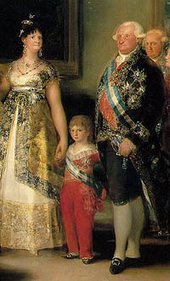Charles IV of Spain
|
|
 Charles IV and his queen Maria Luisa, from The Family of Charles IV by Goya |
| Template:House of Bourbon |
Charles IV (November 11, 1748 - January 20, 1819) was King of Spain from December 14, 1788 until his abdication on March 19, 1808.
| Contents |
Early life
Charles was the second son of Charles III and his wife Maria Amelia of Saxony. He was born at Portici, while his father was king of the Two Sicilies. His elder brother was passed over for the throne as mentally retarded and epileptic. Charles had inherited a great frame and immense physical strength from the Saxon line of his mother. When young he was fond of wrestling with the strongest countrymen he could find. He was considered by many to be intellectually sluggish and quite credulous. His wife Maria Luisa of Parma, on the other hand, was seen by many (including by the painter Francisco Goya) as a vicious and coarse woman who thoroughly dominated the king. During his father's lifetime he was led by her into court intrigues which aimed at driving the king's favourite minister, Floridablanca, from office, and replacing him by Aranda, the chief of the "Aragonese" party.
Children
Charles IV married his first cousin Maria Luisa of Parma (daughter of Philip, Duke of Parma) in 1765. They had 14 children, but only seven reached adulthood:
- María Amalia (1774-1798). Married her uncle Antonio, Infante of Spain (son of Charles III).
- Carlota Joaquina (1775-1830). Married João VI of Portugal.
- María Luísa (1782-1824). Married Louis of Bourbon-Parma.
- Ferdinand VII of Spain
- Carlos María Isidro (1788-1855). Carlist pretender to the throne of Spain.
- María Isabel (1789-1848). Married first her cousin Francis I of the Two Sicilies and second Francesco Count del Balzo.
- Francisco de Paula, Duke de Cádiz (1794-1865). Married his niece Luisa Carlota, daughter of his sister María Isabel and Francis I of the Two Sicilies. Their eldest son, Francisco de Asis de Bourbon, married Isabella II of Spain.
Reign
After he succeeded to the throne in 1788 his one serious occupation was hunting. Affairs were left to be directed by his wife and her lover Manuel de Godoy. Although Godoy essentially took over his wife and his office, the king was favourable towards him for all his life. When terrified by the French Revolution he turned to the Inquisition to help him against the party which would have carried the reforming policy of Charles III much further. But he never took more than a passive part in the direction of his own government. He simply obeyed the impulse given him by the queen and Godoy. In 1803, after smallpox had affected his daughter María Luisa, the king commissioned his doctor Francisco de Balmis to bring the vaccine to the Spanish colonies on state expenses.
He had a profound belief in his divine right and the sanctity of his person. He thought it very important to seem a very powerful monarch, although his kingdom was treated as a mere dependency by France and his throne was dominated by the queen and her lover. Spain allied with France and supported the Continental Blockade, but withdrew after the Battle of Trafalgar. When Napoleon won from Prussia in 1807, Godoy returned to the French side, but France did no longer consider Spain a worthy ally. But even the alliance with France as it was made Godoy's rule unpopular and fueled the partido fernandista, the supporters of Ferdinand, who favored a close relationship with Great Britain.
Abdication
When he was told that his son Ferdinand was appealing to the emperor Napoleon against Godoy, he took the side of the favourite. When the populace rose at Aranjuez in 1808 he abdicated on March 19 to save the minister, who had been taken prisoner. Ferdinand took the throne but was distrusted by Napoleon, who had 100,000 soldiers in Spain by that time.
He took refuge in France, and was the prisoner of Napoleon. He had a difficult time restraining himself from assaulting his son. Then he abdicated in favour of Napoleon's brother Joseph. He accepted a pension from the French emperor and spent the rest of his life between his wife and Godoy. He died in Rome on January 20, 1819.
Reference
- Historia del Reinado de Carlos IV, by General Gomez de Arteche (5 vols.), in the Historia General de España de la Real Academia de la Historia (Madrid, 1892, etc.).
